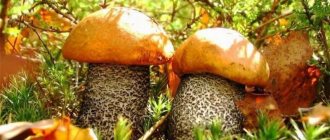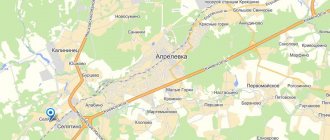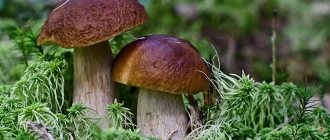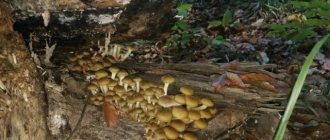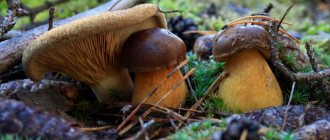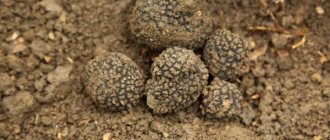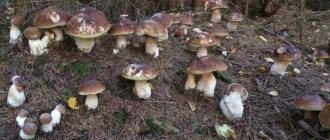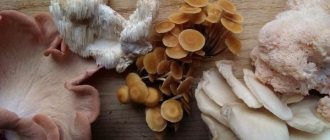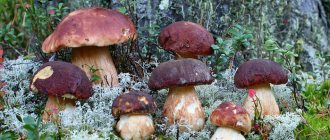Mushroom places in the Moscow region 2022 are what interests fans of tasty “trophies”, which are found in large quantities in forest glades and pine forests after rains, when the air temperature remains at 10 degrees Celsius. Many may be surprised, but in order to collect a good harvest of mushrooms, you don’t need to travel far.
In the Moscow region in the fall, you can actually find many edible species, including diarrhea, valui, russula, volushka, honey mushrooms, saffron milk caps, as well as white mushrooms and many others. It is better to go in search of the above mushrooms before serious cold weather sets in. Carefully study not only the classic “hot spots”, but also the thickets of nettles, as well as the trunks of living trees.
On the map
Map of mushroom places near Moscow 2022 photo
Looking at the mushroom map of the Moscow region, we can conclude that:
- the west of this region is rich in black milk mushrooms, honey mushrooms, and also trumpets (the latter are loved by fans of salted and pickled mushrooms);
- in wooded areas you can find russula, which is soaked before heat treatment;
- Polish mushrooms under spruce plantations until November;
- Near a birch grove in the Moscow region there are good mushroom glades of boletus mushrooms.
If you approach the study of the mushroom map thoroughly, it is better to focus on certain stations, areas and directions.
The Firsanovsky direction is a paradise for those who preferably collect boletus and saffron milk caps. Here in the Stupinsky district, located in the direction of Zavorykin, not far from “Doch Shugarovo”, there are porcini mushrooms. The Odintsovo district is rich mainly in porcini mushrooms, the abundance of which will delight you near Skorotovo, Yamshchino, Uspensky and Khlyupin.
If you are going to move in the Belarusian direction, get off at the stations “Drokhovo”, “Sushkinskaya” (there is a large forest rich in mushrooms) or “Portnovskaya”. You will leave with a decent amount of trophies from Petelino, Tuchkovo, and Shalikovo. Here you will find porcini mushrooms and boletus. Boletus mushrooms are sometimes found.
Mushroom pickers who choose the Volokolamsk direction should focus on wooded areas near the Opalikha and Novoierusalimskaya stations, where they can stock up on boletus and boletus mushrooms.
In the Kazan direction - chanterelles, porcini mushrooms and boletus. Boletus mushrooms also grow here. It is better to start your search from the clearings near Gzhel (go to the villages of Konyashino and Minino if you are interested in porcini mushrooms), Danino, as well as Grigorovo and Ignatyevo stations. White boletuses, boletus, boletus and chanterelles are collected here.
Those traveling in the Kiev direction need to get off at the Beksovo station, where there are milk mushrooms, chanterelles and boletus next to Savelovka, Ivanovka, Mogutovo and Afanasovka. The main thing is to move south of the platform or east. Alternatively, mushroom pickers can also go to the Zosimova Pustyn, Alabino and Rassudovo stations.
Having studied the mushroom places in the Moscow region 2022, we can conclude that the hot spots in the Kursk direction are the Lvovskaya station, next to the Meshcherskaya village (a lot of porcini mushrooms grow here, the main thing is to go east), as well as Sharapova Okhota and Stolbovaya " In wooded areas, russula, chanterelles and nigella are collected with the latter. Butterflies and milk mushrooms also grow here. Moving in the Leningrad direction, get off at the “Golovkino”, “Povarovo” or “Radishchevo” stations, where they “hunt” for chanterelles, saffron milk caps, milk mushrooms, russula, and porcini mushrooms. If you love russula, honey mushrooms, porcini mushrooms and boletus, choose the Savelovskoe direction, namely the forests near the stations “Tourist”, “Morozki” (go to Strekovo, Grigorkovo and Paramonovo), as well as “Iksha”.
TOP mushroom places 2022
In the Moscow region this year, as in the past, there are several mushroom places distinguished by the abundance of edible, aromatic, and most importantly, healthy harvest. The list of current locations that are easy to reach, both by personal car and by public transport, includes:
1) Savelovskoe direction, and in particular the stations: Iksha, Tourist and Morozki. In this area, mushroom pickers have repeatedly collected valuable chanterelles, oyster mushrooms sprouting on logs, distinguished by a pleasant aroma and delicate taste, as well as sulfur-yellow tinder fungus.
2) If you decide to go not by car, but by metro, it is worth considering three stations related to the Yaroslavl direction: Semkhoz, Abramtsevo and Kalistovo. In this area you can hunt for boletus and oyster mushrooms, champignons and boletus.
3) In order not to waste time and gasoline searching for the best mushroom place, you should take a closer look at the Kyiv direction. The forest surroundings located near Naro-Fominsk will certainly delight lovers of porcini mushrooms and summer mushrooms.
4) The most delicious edible, and most importantly popular, mushrooms can be found at Kuzyaevo and 73 km stations. There, not only during the peak season, but also in the off-season, you can find porcini mushrooms, obabkas, bluelegs and autumn honey mushrooms.
5) No less relevant in 2022 were: Frolovskoe, Podrezkovo, Pokrovka and Golovkovo.
How to get there by car?
- Drive from Vnukovo to the junction nearby and turn towards Ankudinovo. This is a good place to park your car near any of the nearby villages. Here you can also collect an impressive amount of mushrooms. An alternative option is to drive to Krekshino, turn right, stop near Aprelevka and comb the local forests.
- Along the Minsk highway, focusing on the Zhavoronok station, drive a little north.
- Drive along New Riga, and as soon as you get to Novy, turn towards Novoarkhangelsk, where there is a place for a car next to the river and go in search of “trophies” in the forest park.
- If you drive along Leningradka or Pyatnitsky, you can stop in the Mitino or Khimki area, but it is better to get to Eleno, which is behind Sheremetyevskoye Highway and Black Gryad.
- You can take the Gorkovskoye Highway (alternatively the Nosovikhinskoye Highway), get to Vlasovo or Subbotino, where there are good mushroom glades in the vicinity.
Where and when to pick mushrooms in the Moscow region?
Everyone knows that mushrooms grow well in warm, humid weather, especially if it is July or August. Most mushroom pickers can be found in mixed and spruce forests, birch groves and pine forests. Cap mushrooms, many of which are edible, usually have a developed mycelium under several tree species at once. In the forests of the Moscow region, mycorrhiza (“fungus root”) often appears near pines, spruces, birches, oaks and aspens. Less common under larches, poplars, alder and rowan. For some edible mushrooms, the organic matter of decaying wood or the forest floor of leaves and needles is more important. Many honey mushrooms are famous for this. There are edible mushrooms that thrive in seemingly completely inappropriate places. For example, on burnt areas and fireplaces you can see the tall morel growing. There are more mushrooms on the edges of the forest, along forest roads, clearings, on lawns, etc. But dense thickets and too high grass stand are considered less suitable places for collecting mushrooms. The first (spring) mushrooms are morels and strings. June - August is the time when the bulk of edible mushrooms appear. The growth of many edible mushrooms is inhibited or ends with the onset of autumn frosts. Although some of them can be collected even with a serious drop in air temperature in late autumn. For example, winter honey fungus. Toward the end, before the beginning of winter, such little-known edible mushrooms as buttercollibia and violet rowan continue to appear.
How to get there by minibus?
If you don’t have a car, and you don’t want to take the train, you don’t have much choice and the choice falls on minibuses. Then the choice of mushroom places narrows.
- Seven enemies. This village can be reached by minibus number 23. It departs from the Domodedovo railway station. Here you will find boletus, boletus and porcini mushrooms.
- New buildings. Get there by bus 45. Get off at the Stepanovo stop, then you have to walk a little. True, you can only get on the bus after reaching the Fryazevo station.
- From the Yuzhnaya metro station you can get to the mushroom place, the village of Melikhovo. Take minibus number 25 at Kursky Station.
- Near “Rumyantsev” you can find a lot of porcini mushrooms, honey mushrooms and boletus mushrooms, as well as moss mushrooms. You can get here by minibuses 590 or 390. Minibuses 1010 and 1011 go in this direction. They depart from Troparevo.
- Take minibus 22 to Khlyupino, where you will collect honey mushrooms, boletus and porcini mushrooms.
Mushroom places in the Moscow region 2022 will not disappoint you. The main thing is to draw a route in advance, focusing on the most, in the opinion of experienced mushroom pickers, hot spots.
Map of mushroom places in the Moscow region - Version 1
Map of the Moscow region - mushroom picker map
This is probably the most detailed map. In terms of size, for sure. And according to the data... check.
Map of the Moscow region: opens in a new window. The size is large, traffic!)
How to distinguish false honey mushrooms from real ones by the stem?
If the hat did not help you, and you continue to doubt, pay attention to another part of your forest find. You can also tell a lot about a particular mushroom by looking at its stem. For example, false and edible honey mushrooms have completely different morphological characteristics. On the latter, the first thing you will notice on the leg is the so-called “skirt” - a small edging that is located just below the cap. All mushroom pickers know this “ring” and often use it to determine whether a mushroom can be taken or not.
Remember that some false honey mushrooms also have a small “skirt”, only in them it is weakly expressed. Therefore, if you see something similar to the remains of a “ring” on the stem of a mushroom, it is better to leave it in the forest. Also pay attention to the height. If the length of the stem is 5-10 centimeters, then most likely the mushrooms are inedible. In an ordinary real honey mushroom, it is no more than 4-6 centimeters. Of course, there are exceptions. Meadow honey mushrooms, absolutely edible, reach a height of 0.3 meters. Therefore, keep this in mind when you go into the forest for another portion of delicious mushrooms.
How to distinguish real mushrooms
Edible species in nature have poisonous counterparts. The collection process takes into account the following:
- edibles do not grow on the earthen surface, they grow on wood, branches or cuttings of foliage;
- the mushroom caps of inedible false mushrooms are much more contrasting in color, have bright colors: from red to green and gray, the color of the mushroom hymenophore plates is noticeably darker;
- The main feature of edible specimens is considered to be the presence of a leathery ring located directly under the mushroom cap on a stalk; false doubles have only inconspicuous scraps instead of a ring;
- the mushroom cap and leg of a real honey mushroom are covered with scales, while the false one does not have them;
- The edible honey fungus has a pleasant mushroom smell, while the false honey fungus has an earthy smell.
Experts about the 2018 mushroom season
The weather has been hot in the Moscow region, with frequent short-term rains: such conditions, according to experts, are very good for the growth of mushrooms. The current week will also be characterized by high air temperatures - plus 29-31 degrees, there will be thunderstorms with showers: next weekend it is quite possible to go to the forest.
July is the month in which chanterelles grow especially well. These amazing mushrooms never rot or dry out, and are never wormy. Chanterelles tolerate transportation well - they do not crumble or break, so they can be collected in buckets and bags, and not just in baskets.
How to choose the right honey fungus based on its cap?
The color of mushrooms largely depends on the place where they grow. The amount of sun rays and the degree of their penetration through the forest thicket also play a special role. But still, there are several special signs, having studied which you will certainly know how to distinguish false honey mushrooms from real ones. First, pay attention to the hat. In edible ones, it is light brown in color, slightly muted, with small dark scales clearly visible on it. False honey mushrooms usually have a brick or gray-yellow cap. However, you will not find scales on it.
The color of the record also plays a special role. If it is creamy, white-yellowish or light brown, then feel free to cut the mushroom. It is suitable for consumption and will delight you with a delicious lunch at home. In false mushrooms, the plate is yellow if they are young, and green or olive if they are old. Carefully examine the mushroom for the presence or absence of these signs and only then decide whether or not to put it in your basket.
